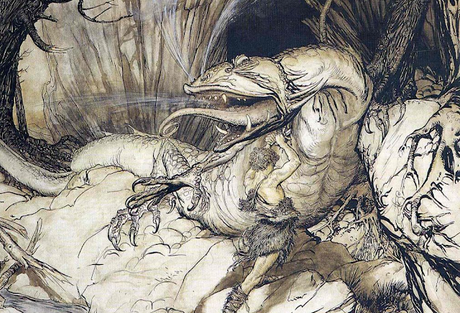by Paul J. Pelkonen

Siegfried battles Fafner in Arthur Rackham's classic drawings based on Wagner's Ring.
Researchers digging through a hidden sub-basement in Schloss Neuschwanstein in south-western Bavaria have discovered a hidden archive belonging to the castle's owner, King Ludwig II. In that archive was found a leather folio of sheet music: the complete score of a previously unheard chapter of Richard Wagner's opera cycle Der Ring des Nibelungen. The discovery sent shock waves through the halls of Wagner scholarship.The opera, called Die Waldgeister ("The Forest Spirits") deals with the vague period following Das Rheingold the first part of the cycle. It shows the various paths of the giant Fafner, the dwarf Mime and his brother Alberich to a dark and mysterious forest: the same forest where the events of the opera Siegfried take place. Wagner intended this work to be a light, fantastical comedy that would be played alternatingly with the serious human drama of Die Walküre.
The existence of a fifth part of the Ring cycle has stunned the Bayreuth Festival, the German institution that was founded by the composer himself for the performance of his works. "At first, we thought it was a piece of juvenalia" team leader Engelbert Kuhcheisse told reporters, "one of the early pieces that the composer later dismissed. "But further research has shown us that this was a private commission for the Bavarian King Ludwig II, and a missing chapter of the Ring Cycle."
Dr. Kuhscheisse, who teaches band class at the New Bayreuth Gymnasium, first learned of this fifth Ring opera when poring through the private family documents that escaped the bombing of Wahnfried. "It was Cosima who buried any trace of this opera," he explained. "She wanted strict control of Richard's legacy and thought that this piece, which Wagner wrote as a condition of the King's patronage, wasn't very good."
"However," he adds, "it has some really great brass writing!"
"It's not really a full festival play, more like a long second prologue to the events of Die Walküre" said Alsatian critic Fritz Knoblauchatem. "You can think of it as what the Americans call an "interquel": where we find out what happened to some of the less popular characters, and it sets up events in the later operas to be a little closer to the mythology as we know it."
The first tableau features a long transformation scene where Fafner uses the magic Tarnhelm to slowly turn into a dragon. There's a comic scherzo with a large choral part set on the Rhine River. In it, Mime tries to stop his brother Alberich from wooing the Burgundian queen Grimhild, who would later be the mother of Hagen. A tavern scene shows the gods Froh and Donner out on the town with Wotan on the night he meets the mother of Siegmund and Sieglinde.
"The music is developed from the themes in Das Rheingold," explains musicologist Greta Nasenpflücker. "It just develops in a different musical direction and fills in some of the blanks and plot questions that trouble every Wagnerian at one time or another. Where did Hagen come from? Why does Mime hate Siegfried so much? And how did Fafner manage to fit himself and all that treasure in the Neidhole?" A performance lasts about three hours, with two intermissions so it's short for a Wagner opera.
In the history and study of Wagner, other "phantom" Wagner operas that have popped up over the years. The composer wrote sketches for works like Die Sieger (based on the life of the Buddha) Wieland der Schmidt and Die glücklichen kleinen Elfen gehen ins Zuckerland. The last was a gift for his music assistant Engelbert Humperdinck, whose opera output included fairy tale operas like Hansel und Gretel and Königskinder.
The score of Die Waldgeister was discovered at Neuschwannstein after researchers found a secret passage in the castle's cellar, reached by pressing carefully on the faulds of the armor worn in a grimy old mural of the Wagner hero Lohengrin. The wall rolled back silently, revealing a dusty, winding stair and a five-room maze of twisty passages, all alike. They eventually led to Ludwig's private archives. In one of the oiled teak cabinets sat the complete orchestral score, dedicated to King Ludwig as "Wagner's great friend, savior and benefactor." It has been authenticated by Dr. Nasenpflücker as being in Wagner's own hand.
The Bayreuth Festival has claimed the rights to the first performance of Die Waldgeister. After its premiere at a special gala performance, this new work will be mounted as part of the new five-day festival that makes up a complete cycle of Wagner's Ring. Following these performances, the work is expected to play at Salzburg, the Metropolitan Opera and Teatro de Colon in Buenos Aires.
If you enjoyed this article, it's time to click over to Superconductor's Patreon page, and help support the cost of independent music journalism in New York City at the low cost of just $5/month.

